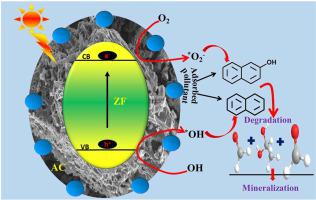Sustainable Chemistry and Pharmacy ( IF 5.5 ) Pub Date : 2020-09-15 , DOI: 10.1016/j.scp.2020.100290 Ajay Kumar , Deepak Pathania , Nidhi Gupta , Pushap Raj , Arush Sharma

|
In the present work, we describe the remediation of noxious naphthalene (NPN) and 2-naphthol (2-NP) from aqueous phase under visible irradiation. The activated carbon/ZnFe2O4 (AC/ZF) nanocomposite was synthesized by simple co-precipitation method. The various instrumental techniques such as Fourier transform infrared (FTIR) spectroscopy, X-ray diffraction (XRD) pattern, surface area analyzer Brunauer-Emmett-Teller (BET), vibrating sample magnetometer (VSM), field emission scanning electron microscopy (FESEM), high resolution transmission electron microscopy (HRTEM), small area diffraction (SAED) pattern, electron dispersive X-ray (EDX), and photoluminescence spectra (PL) were used to study the detailed anatomy of prepared nanocomposite. The XRD, HRTEM, and SAED results indicated that AC/ZF composite has been prepared in nano-phase. The degradation of organic pollutants was studied using high resolution mass spectrometry (HRMS), chemical oxygen demand (COD), and UV–visible (UV–vis) spectrophotometry. The degradation efficiencies of 86.41% and 92.81% were recorded for NPN and 2-NP, respectively, using AC/ZF nanocomposite under synergetic adsorption-photocatalysis (AP) after 160 min of solar illumination. The augmented photocatalytic degradation of pollutants mainly ensued due to the mesoporous nature of the nanocomposite and strongly improved charge separation efficiency of AC/ZF. Therefore, our investigations might reveal a novel, economical, and proficient photoactive material for the removal of highly noxious pollutants from water systems.
中文翻译:

Corn树茎杆支撑的ZnFe 2 O 4磁性生物纳米复合材料光降解水系统中的有害污染物
在本工作中,我们描述了在可见光照射下从水相中修复有毒萘(NPN)和2-萘酚(2-NP)的方法。活性炭/ ZnFe 2 O 4通过简单的共沉淀法合成了(AC / ZF)纳米复合材料。各种仪器技术,例如傅立叶变换红外(FTIR)光谱,X射线衍射(XRD)图,表面积分析仪Brunauer-Emmett-Teller(BET),振动样品磁力计(VSM),场发射扫描电子显微镜(FESEM) ,高分辨率透射电子显微镜(HRTEM),小面积衍射(SAED)图,电子色散X射线(EDX)和光致发光光谱(PL)用于研究制备的纳米复合材料的详细解剖结构。XRD,HRTEM和SAED结果表明,AC / ZF复合材料已经制备成纳米相。使用高分辨率质谱(HRMS),化学需氧量(COD)和紫外可见光(UV-vis)分光光度法研究了有机污染物的降解。在太阳光照射160分钟后,使用AC / ZF纳米复合材料在协同吸附-光催化(AP)下记录的NPN和2-NP的降解效率分别为86.41%和92.81%。随之而来的是污染物的光催化降解增强,这主要归因于纳米复合材料的介孔性质以及AC / ZF的电荷分离效率大大提高。因此,我们的研究可能会揭示出一种新颖,经济,精通的光敏材料,用于从水系统中去除高毒污染物。随之而来的是污染物的光催化降解增强,这主要归因于纳米复合材料的介孔性质以及AC / ZF的电荷分离效率大大提高。因此,我们的研究可能会揭示出一种新颖,经济,精通的光敏材料,用于从水系统中去除高毒污染物。主要由于纳米复合材料的介孔性质和大大提高的AC / ZF电荷分离效率而导致的污染物的光催化降解增强。因此,我们的研究可能会揭示出一种新颖,经济,精通的光敏材料,用于从水系统中去除高毒污染物。











































 京公网安备 11010802027423号
京公网安备 11010802027423号